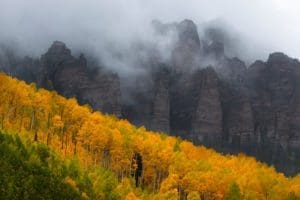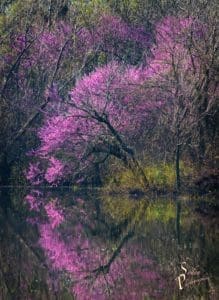Ok, time to get another interview with a Kansas photographer online! If you’ve missed the previous interviews in this series check out the interviews with Jim Griggs, Brad Mangas, and Harland Schuster.

I’m going get this interview started off with Jason’s photo of Kahola falls at night. I first saw this photo in Kansas! Magazine and was immediately mesmerized by it. In fact I liked this photo so much that I went out to try shooting a waterfall at night by myself shortly after seeing this in print. Funny story about that evening…at the time I was wearing a pedometer to count how many steps I was getting each day (and in case you are wondering, I was way short of 10,000). The particular pedometer I had a voice feature where at every 1000 steps it would play a recording say “you have walked 1000 steps.” This recording was fairly loud and very easy to hear. When I left the house that evening to try some waterfall night shooting I forgot that I was still wearing the pedometer. I spend a couple of hours shooting and around midnight I stopped and was standing by my tripod enjoying the night. As I started to move around to pack up my gear, I heard a voice right next to me say “you have walked…” and I must have jumped 10′ straight up. I had hit the right number of steps to activate the voice feature on the pedometer and it scared me to death. Lesson learned, don’t buy talking pedometers! On to the interview questions.
Scott: This night photo of Kahola Falls is fantastic. What let you to shoot this at night?
Jason: Me and some friends would make an annual trip down to Kahola Falls in late September, early October, and spend the night out at the falls. One year, there was a near full moon, and it made the falls look as if they were glowing. It was unbelievable! The next year I made it a point to plan our annual overnighter at Kahola Falls during the full moon so I could photograph it.
Scott: Did you have to do anything special to get this shot? Any special issues you needed to deal with?
Jason: Yes, Scott, there were a few variables that I needed to be aware of. First is the issue with night photography. I obviously needed a tripod for my long exposure time of 10 seconds. Second, the falls need to be facing the moon properly to get the glowing effect. Next, keep an eye on the weather. Clear skies are needed with relatively low humidity. High humidity would keep some of the moonlight from penetrating the atmosphere, and thus, not illuminating the water. Lastly, Kahola Falls is now private land. The residents of Lake Kahola purchased the falls property from the city of Emporia and quickly disallowed non residents down at the falls. Be sure to get permission from the Lake Kahola authorities before going to the falls!
Scott: How did you get started in photography?
Jason: I took photography as a general elective class while at Washburn University. I’ve been hooked ever since.
Scott: How did you learn photography, and what were some of the things that helped you along when you were just learning?
Jason: I’m still learning to this day. The class I took at Washburn got me started. About 95% of what I’ve learned has been with the help of magazines and books. My present day composition techniques are basically the result of what I perceive as errors from previous attempts, and influences from other photographers.
Scott: What photographers have influenced/inspired you?
Jason: I love the work of Gordon Parks and Dorothea Lange. From a landscape perspective, the late Galen Rowell is my favorite! I loved reading his articles. They were so full of passion. I still remember when I first saw the headline on a photography magazine that he died in a plane crash.
(I remember the day I heard about Galen Rowell’s death too, I always looked forward to reading his columns in Outdoor Photographer).
Scott: What piece of advice would you give photographers just starting out today, and what are the most important things they need to remember?
Jason: Photographers starting out today need to listen to other photographers around them. Don’t get offended if somebody gives advice that’s something other than praise. Having the ability to listen to others critiquing of your work is huge. Don’t take it personally if a magazine, gallery or even an individual doesn’t accept your work. The second piece of advice I’d like to mention is the “gotta have it” mentality I see all too often. DO NOT get stuck in the mindset thinking you must have the latest gadget or cameras that come out. It’s not the camera that makes the photographer great, just like it’s not the pots and pans that make a chef great! Many people are surprised that I only own two lenses used for landscape photography. The 16-35mm and the 70-200mm. That’s it. I have a 50mm I use for portraits. I often see photographers show up to a photo shoot using multiple cameras with multiple lenses at the same time. They’re so busy switching cameras and/ or lenses that they don’t slow down enough to absorb and appreciate their surroundings.
Scott: Why do you make photographs? What motivates you to head out the door with a camera?
Jason: I love being able to stop and preserve a moment in time. For example, if I’m in the Flint Hills of Kansas, and I see and photograph a thunderstorm, that exact moment of time, cloud structures, animals, grasses, etc, will NEVER appear the same again, and I was lucky enough to be able to experience that exact moment in person!
(Excellent reminder that each moment only exists once, never take any for granted).
Scott: You have made some fantastic photos of storms and have mentioned that as a passion of yours. How did you get started shooting storms?
Jason: I have loved meteorology since I was a kid. Photographing a storm is a way of merging two passions together. I started photographing storms since I’ve picked up a camera, but only recently have really began to dedicate a large portion of my landscape photography to storms, and the influence of storms, and clouds in my landscape images.
Scott: What kinds of weather forecasts or other information do you use to let you know that storms might be coming?
Jason: Besides the local forecast, I rely on the Storms Prediction Center website. They have an array of maps and predictive synopses that I read. Local or regional stormchasers websites and Facebook pages also provide a wealth of information. Many times, I just use my intuition and gut feelings based on what I’ve learned. I’ve taken college courses on meteorology to further my knowledge on the subject, and have read books about meteorology, and talked to stormchasers when I have questions.
Scott: Storms can turn dangerous easily. What kind of safety issues do people need to be aware of if they are thinking of photographing a storm?
Jason: First and foremost, use common sense!! If a storm gets too bad, pull over if you’re driving. Studying and understanding how storms function is really important. I see way too many people venturing into storms that have no idea what they’re doing. One of the most dangerous elements of a severe thunderstorm is the flash flooding. DO NOT drive through standing water on roadways. If photographing lightning, photograph into the storm from the outside of it. There is no fail-safe method to photographing lightning. When I watch a storm, I notice that the lightning often comes and goes in patterns, but is never entirely predictable. A way to minimize the risk is to set the camera up on a tripod and use a wireless remote from inside your car with the window rolled up. This does not eliminate all of the risk, but it can help. If the storm is tornado warned, it is best to leave it to qualified and educated individuals. Don’t attempt to chase a tornadic storm without adequate knowledge of how tornadoes will behave!
Scott: What would be your ideal Kansas photography setting/location?
Jason: In the Flint Hills during the spring wildflower bloom, watching a thunderstorm off in the distance, at sunset.
(I can’t wait to see the photograph Jason makes when he gets to experience that moment!)
Scott: What do you find most challenging about photographing Kansas?
Jason: What I find most challenging about photographing Kansas is finding unique ways and perspectives of viewing the Kansas landscape. In the current era of digital imagery, more people than ever are getting involved in photography. In years such as 2012, it becomes more of a challenge to come up with new and fresh photographs as the Kansas landscape continues to shrivel from the drought and excessive heat. When a photographic possibility opens up, thanks to today’s digital communications, it isn’t unusual to see multiple dozens of photographers at a single location over a short time frame. It’s a challenge coming up with unseen perspectives and landscapes that haven’t already been displayed on social media and in galleries.
Scott: What do you want your photographs to say about Kansas?
Jason: I want my photographs to say that Kansas isn’t a barren flatland like its reputation suggests. There are many hidden, scenic areas to enjoy. Kansas should be looked at as something other than the quickest route to Colorado. I find few things as awe inspiring as watching a 60,000 foot thunderstorm churning over the horizon. Imagine, something twice the height of Mt. Everest dropping lightning and rain, producing an array of different types of clouds.
(Excellent point about how inspiring Kansas skies can be and the raw beauty in what is happening in those skies).
Scott: Anything else you would like to add?
Jason: One of my main goals going forward is to begin displaying and making more people aware of my work. I have seldom displayed my work to the public, nor have I marketed my work. Those will be things I really work on going forward.
Today there are more people than ever before interested in becoming photographers. When I first became interested in photography over 10 years ago, there were a few landscape photographers that I knew of in northeast Kansas. A few years ago, it seemed like every small town had at least one photographer, and now it’s getting to the point of every neighborhood having an aspiring photographer. My step-son’s baseball team had 10 kids, and parents of four of those kids called themselves photographers, or aspiring photographers, interested in making money off of their cameras. Whether landscape or portraiture, in order to succeed, you must have a passion about your art and your surroundings, and a willingness to continue to learn and evolve, and most importantly, have fun and enjoy it!
A huge thanks for Jason for taking the time to answer these questions!! You can view more of Jason’s work on his website: http://www.jasonsodenphotography.com/. Some additional photos from Jason are included below as well. Please take the opportunity to enjoy his work. Thanks for stopping by!







